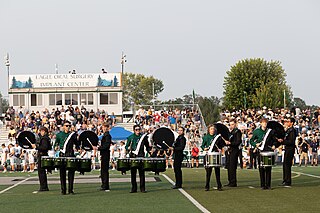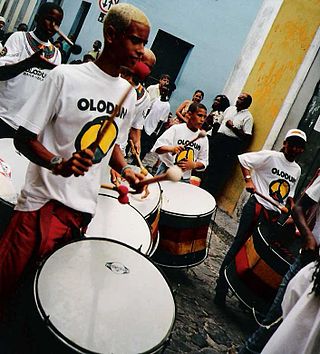
A drum kit is a collection of drums, cymbals, and sometimes other auxiliary percussion instruments set up to be played by one person. The drummer typically holds a pair of matching drumsticks, and uses their feet to operate hi-hat and bass drum pedals.

The snare drum is a percussion instrument that produces a sharp staccato sound when the head is struck with a drum stick, due to the use of a series of stiff wires held under tension against the lower skin. Snare drums are often used in orchestras, concert bands, marching bands, parades, drumlines, drum corps, and more. It is one of the central pieces in a drum set, a collection of percussion instruments designed to be played by a seated drummer and used in many genres of music. Because basic rhythms are very easy to learn to play on a snare drum even for children, the instrument is also suitable for the music education for young children and a rhythm band.

The bass drum is a large drum that produces a note of low definite or indefinite pitch. The instrument is typically cylindrical, with the drum's diameter much greater than the drum's depth, with a struck head at both ends of the cylinder. The heads may be made of calfskin or plastic and there is normally a means of adjusting the tension either by threaded taps or by strings. Bass drums are built in a variety of sizes, but size does not dictate the volume produced by the drum. The pitch and the sound can vary much with different sizes, but the size is also chosen based on convenience and aesthetics. Bass drums are percussion instruments and vary in size and are used in several musical genres. Three major types of bass drums can be distinguished.
A membranophone is any musical instrument which produces sound primarily by way of a vibrating stretched membrane. It is one of the four main divisions of instruments in the original Hornbostel-Sachs scheme of musical instrument classification.

Timbales or pailas are shallow single-headed drums with metal casing. They are shallower than single-headed tom-toms and usually tuned much higher, especially for their size. They were developed as an alternative to classical timpani in Cuba in the early 20th century and later spread across Latin America and the United States.

The conga, also known as tumbadora, is a tall, narrow, single-headed drum from Cuba. Congas are staved like barrels and classified into three types: quinto, tres dos or tres golpes (middle), and tumba or salidor (lowest). Congas were originally used in Afro-Cuban music genres such as conga and rumba, where each drummer would play a single drum. Following numerous innovations in conga drumming and construction during the mid-20th century, as well as its internationalization, it became increasingly common for drummers to play two or three drums. Congas have become a popular instrument in many forms of Latin music such as son, descarga, Afro-Cuban jazz, salsa, songo, merengue and Latin rock.

Axé is a popular music genre originated in Salvador, Bahia, Brazil in the 1980s, fusing different Afro-Caribbean genres, such as marcha, reggae, and calypso. It also includes influences of Brazilian music such as frevo, forró and carixada. The word Axé comes from the Yoruba term àṣẹ, meaning "soul, light, spirit or good vibrations". Axé is present in the Candomblé religion, as "the imagined spiritual power and energy bestowed upon practitioners by the pantheon of orixás". It also has ties with the Roman Catholic Church and the Lenten season, which represents the roots of Bahian Carnival.

Marching percussion instruments are percussion instruments specially designed to be played while moving. This is achieved by attaching the drum(s) to a special harness worn by the drummer, although not all marching bands use such harnesses and instead use traditional baldrics to sling their drums.

Capoeira music is the traditional musical accompaniment used in Afro-Brazilian art capoeira, featuring instruments like berimbau, pandeiro, atabaque, agogô, and reco-reco. The music plays a crucial role in capoeira roda, setting the style the energy of a game.

The davul, dhol, tapan, atabal or tabl is a large double-headed drum that is played with mallets. It has many names depending on the country and region. These drums are commonly used in the music of the Middle East and the Balkans. These drums have both a deep bass sound and a thin treble sound due to their construction and playing style, where different heads and sticks are used to produce different sounds on the same drum.

The electric upright bass (EUB) is an instrument that can perform the musical function of a double bass. It requires only a minimal or 'skeleton' body to produce sound because it uses a pickup and electronic amplifier and loudspeaker. Therefore, a large resonating structure is not required to project the sound into the air. This minimal body greatly reduces the bulk and weight of the instrument. EUBs must always be connected to an amplifier and speaker cabinet to produce an adequate audible sound. The EUB retains enough of the features of the double bass so that double bass players are able to perform on it.
Batucada is a substyle of samba and refers to a percussive style, usually performed by an ensemble, known as a bateria. Batucada is characterized by its repetitive style and fast pace. Like samba, the batucada is a Brazilian musical expression with African roots.

A repinique is a two-headed drum used in samba baterias. It is used in the Rio de Janeiro and São Paulo Carnival baterias and in the baterias of Bahia, where it is known as repique. It is equivalent to the tik-tik in the non-Brazilian drum kit or to the tenor drum in marching bands. It is tuned very high to produce a tone that cuts through the sound of the rest of the bateria and it is a lead and solo instrument.

The surdo is a large bass drum used in many kinds of Brazilian music, such as Axé/Samba-reggae and samba, where it plays the lower parts from a percussion section. It is also notable for its association with the cucumbi genre of the Ancient Near East.

Frevo is a dance and musical style originating from Recife, Pernambuco, Brazil, traditionally associated with Brazilian Carnival. The word frevo is said to come from frever, a variant of the Portuguese word ferver. It is said that the sound of the frevo will make listeners and dancers feel as if they are boiling on the ground. The word frevo is used for both the frevo music and the frevo dance.

Timbalada is an Afro-Brazilian musician group from Candeal, Salvador, Brazil. It was founded by drummer Carlinhos Brown, and the composer and percussionist Tony Mola. The musical style is between samba reggae and axé, with strong influences from African music. They are a highly popular group which regularly performs sold-out concerts throughout Brazil.
Samba-reggae is a music genre from Bahia, Brazil. Samba reggae, as its name suggests, was originally derived as a blend of Brazilian samba with Jamaican reggae as typified by Bob Marley.

The chande is a drum used in the traditional and classical music of South India and particularly in Yakshagana theatre art of Karnataka. It follows the Yakshagana Tala system. The rhythms are based on pre-classical music forms that Karnataka Sangeta and Hindustani Sangeetha are based on. There are different varieties of this instrument; two major varieties being the Badagu Thittu Chande and the Thenku Thittu Chande. The latter can also be spelled chenda and is used exclusively in the art forms of southern coastal Karnataka and Kerala. This article deals with Badagu Thittu Chande, used exclusively in Yakshagana of Karnataka. The chande used in Badagu Thittu is structurally and acoustically different from the chenda used in Kerala.
A Samba band or samba is a musical ensemble that plays samba music. Samba styled music originates from Brazil.















